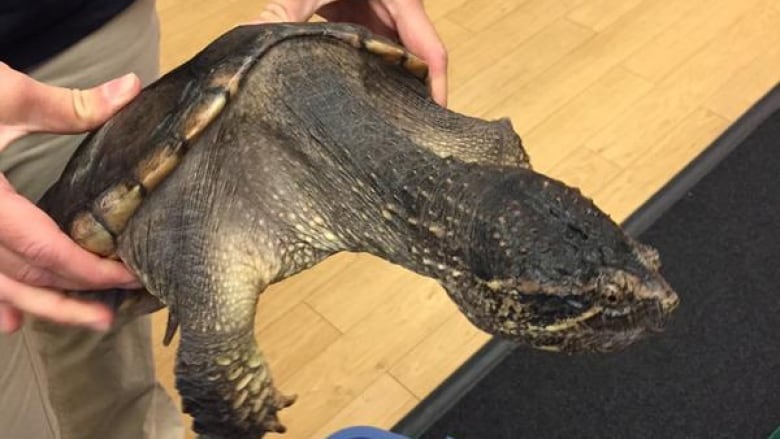A snapping turtle can potentially kill a person if it bites them forcefully. Snapping turtles, known for their powerful jaws and sharp beaks, have the ability to cause serious harm if provoked or mishandled.
With their strong bite force, they can inflict deep wounds and lacerations, capable of causing significant pain and even leading to infection if not properly treated. While they generally prefer to avoid human interaction, it is crucial to exercise caution when encountering these reptiles in their natural habitats or while attempting to handle them.
Understanding the potential danger they pose can help ensure our safety and encourage responsible behavior around these fascinating yet powerful creatures.

Credit: www.cbc.ca
Understanding Snapping Turtles
Snapping turtles are known for their large and powerful jaws, making them one of the most feared reptiles. Their shells can vary in color, with some individuals having a dark brown or black shell, while others may have a lighter shade. They have strong limbs with sharp claws that enable them to move and defend themselves effectively. Their size can range from 8 to 18 inches, and adult snapping turtles can weigh between 10 to 35 pounds. The head of the snapping turtle is large and possesses a pointed snout, often characterized by a distinctive hooked beak.
Snapping turtles are primarily found in freshwater habitats, such as ponds, lakes, and marshes. They prefer areas with ample vegetation and muddy bottoms. Snapping turtles are solitary creatures and generally remain near their preferred habitat, only venturing out for mating and laying eggs. They are known for their aggressive behavior and can become quite hostile if provoked. When threatened, they rely on their strong jaws to snap at their perceived threats, which is where they get their name.
Snapping turtles are opportunistic feeders and have a varied diet. They are known to consume a wide range of prey, including fish, frogs, snakes, birds, small mammals, and even other turtles. They are also scavengers and will feed on dead animals. Snapping turtles use their keen sense of smell and powerful jaws to catch their prey. They often lie in wait at the bottom of the water, camouflaging themselves with mud and debris, and strike swiftly when an unsuspecting prey approaches. Their strong jaws and sharp beak enable them to easily break through the tough shells of their prey.
Credit: www.quora.com
Potential Dangers Of Snapping Turtles
Bites and Injuries:
Bites: Snapping turtles possess a strong bite force, and if provoked or mishandled, they can cause serious injuries. Their sharp beaks can easily penetrate the skin and inflict deep wounds. It is important to exercise caution when approaching or handling a snapping turtle to avoid getting bitten.
Infections: Snapping turtle bites can lead to the risk of infections. Their mouths harbor bacteria such as salmonella, which can cause severe illnesses. It is crucial to thoroughly clean and disinfect any wound caused by a snapping turtle bite and seek medical attention to prevent the onset of infections.
Diseases: Snapping turtles may carry diseases, such as shell rot or respiratory infections, which can be transmitted to humans through contact. It is advisable to avoid direct contact with snapping turtles, especially if they appear sick or exhibit any signs of illness.
How To Stay Safe Around Snapping Turtles
Snapping turtles are known for their aggressive nature and powerful jaws, but by taking a few precautions, you can ensure your safety when encountering these creatures.
Avoiding Encounters
- When hiking near water bodies, stay alert and keep your distance from areas where snapping turtles are known to inhabit.
- Avoid approaching snapping turtles if you spot them on land or in the water.
- Keep children and pets away from snapping turtle habitats to minimize the risk of an encounter.
Handling Techniques
- If you need to move a snapping turtle, do not attempt to pick it up with your bare hands. Instead, use a shovel or a long stick to gently prod it from a safe distance.
- If you happen to get bitten by a snapping turtle, seek medical attention immediately to prevent infection.
Protecting Pets And Wildlife
- Keep your pets on a leash when near water bodies to prevent them from getting too close to snapping turtles.
- For wildlife preservation, avoid disturbing snapping turtle nests and refrain from removing turtles from their natural habitats.
By following these precautions, you can enjoy nature while staying safe from snapping turtles and ensuring their conservation.

Credit: www.reconnectwithnature.org
Conclusion
While snapping turtles are strong and have powerful jaws, they are unlikely to kill humans unless provoked. However, caution should still be exercised as their bites can cause serious injuries. Understanding their behavior and giving them the space they need can help prevent any potential harm.
So, if you encounter a snapping turtle, it’s best to observe from a distance and let them be. Stay safe and respect these fascinating creatures in their natural habitat.






Leave a Reply